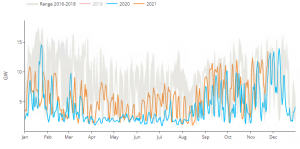

It seems China has overshot in its efforts to avert a coal and power supply crisis this winter, with fears now growing that faltering consumption is flipping the market into oversupply.
Daily domestic coal production has hovered at a record 12.00 Mt/d in November, up from 11.52 Mt/d in October, 11.14 Mt/d in September and 10.81 Mt/d in August.
However, coal burn has receded in recent weeks as industrial activity wanes amid a broader economic easing, earlier power shortages and rationing, and controls on energy intensive sectors.

Power consumption from industrial users was 442.0 TWh in October, up by 3.1% y-o-y but down considerably from growth of 11.0% for January-October.
However, domestic coal prices, which dropped significantly from mid-October, stabilized last week.
December 2021 prices on the China Zhengzhou Commodity Exchange increased at the start of the week, before falling on Friday as the discovery of a new variant of the Covid-19 caused widespread panic in energy markets; they closed at $153.589/t, down by 0.8% week-on-week.
In Europe, API2 Cal 2022 prices continued their technical rebound, with additional support from the disruption in Russian supplies following a fatal methane gas explosion in a mine. Despite a significant drop on Friday, closing at $117.80/t, they were up by $3.69 week-on-week.
January 2022 prices on the China Zhengzhou Commodity Exchange dropped by 5.4% (to $128.622/t) this Monday after the National Development and Reform Commission (NDRC) signaled further regulations on coal prices.
Although it did not disclose any details of the price level, this announcement is likely to exert a downward pressure on global coal prices, in a context of more comfortable China coal fundamentals.
Source: Energyscan









